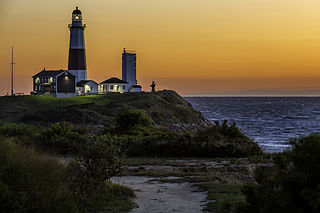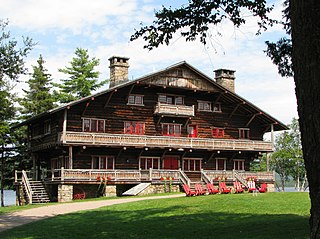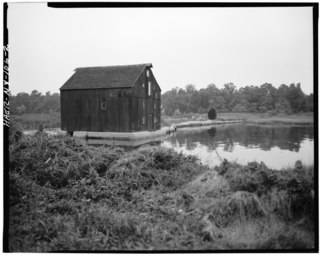Related Research Articles

Suffolk County is the easternmost county in the U.S. state of New York. It comprises the eastern two-thirds of Long Island, bordered to its west by Nassau County, to its east by Gardiners Bay and the Atlantic Ocean, to its north by Long Island Sound, and to its south by Great South Bay.

Cold Spring Harbor is a hamlet and census-designated place (CDP) in the Town of Huntington, in Suffolk County, on the North Shore of Long Island in New York. As of the 2010 United States census, the CDP population was 5,070.

The Town of Huntington is one of ten towns in Suffolk County, New York. Founded in 1653, it is located on the north shore of Long Island in northwestern Suffolk County, with Long Island Sound to its north and Nassau County adjacent to the west. Huntington is part of the New York metropolitan area. As of the 2020 census, the town population was 204,127, making it the 11th most populous city/town in the state.

Pittsford is a village in Monroe County, New York, United States. The population was 1,355 at the 2010 census. It is named after Pittsford, Vermont, the native town of a founding father.

The Town of East Hampton is located in southeastern Suffolk County, New York, at the eastern end of the South Shore of Long Island. It is the easternmost town in the state of New York. At the time of the 2020 United States census, it had a total population of 28,385.

Great Camp Sagamore is one of several historic Great Camps located in the Adirondack Mountains of northern New York State.

The North Shore of Long Island is the area along the northern coast of New York's Long Island bordering Long Island Sound. Known for its extreme wealth and lavish estates, the North Shore exploded into affluence at the turn of the 20th century, earning it the nickname the Gold Coast. Historically, this term refers to the affluent coastline neighborhoods of the towns of North Hempstead and Oyster Bay in Nassau County and Huntington in Suffolk County. Some definitions may also include the parts of Smithtown that face the Sound. The region is also largely coextensive with the Gold Coast region of Long Island, though this region excludes Smithtown, as the easternmost Gold Coast mansion is the Geissler Estate, located just west of Indian Hills Country Club in the Fort Salonga section of Huntington.

Coindre Hall, originally called West Neck Farm, is a 40-room, 80,000-square-foot (7,400 m2) mansion in the style of a medieval French château completed in 1912 for pharmaceutical magnate George McKesson Brown. Coindre Hall sits on 33 acres (13 ha) of rolling land overlooking Huntington Harbor, near the Long Island Sound.

The Georgia Trust for Historic Preservation is the United States' largest statewide, nonprofit preservation organization with more than 8,000 members. Founded in 1973 by Mary Gregory Jewett and others, the Trust is committed to preserving and enhancing Georgia's communities and their diverse historic resources for the education and enjoyment of all.
Freetown is an unincorporated hamlet in the Town of East Hampton, NY, settled in the 19th century by free people of African and Native American descent, as well as people of European descent. Freetown retained its multicultural character throughout the 20th century, evolving into a largely working-class neighborhood occupied by East Hampton's labor force. During the 2010s and 2020s, surviving historic properties in Freetown are increasingly threatened by demolition and intensive redevelopment to make way for luxury real estate and other out-of-scale and out-of-character new construction.

The John Coltrane Home is a ranch house in Dix Hills, New York, where jazz saxophonist John Coltrane lived with his family from 1964 until his death in 1967. Coltrane composed his album A Love Supreme, widely considered his magnum opus, in his practice room in the house.

Corwith Windmill at Water Mill is a historic mill on NY 27 and Halsey Lane in Southampton, New York.

Norwichtown is a historic neighborhood in the city of Norwich, Connecticut. It is generally the area immediately north of the Yantic River between I-395 and Route 169.

Holt House is an historic house, located on the grounds of the National Zoo in Washington, D.C. Thought to have been built before 1814, it is one of the most important examples of early Neoclassical architecture in the city, and was one of the major houses in the new national capital when it was built. Since 1889, its caretaker has been the Smithsonian Institution. It is the oldest building under the Smithsonian's management, but has been left vacant since the 1980s.

The Joseph Lloyd Manor house is a historical site and Literary Landmark located in Lloyd Harbor, Suffolk County New York. The house was built between 1766 and 1767 on the Manor of Queens Village, a 3,000-acre provisioning plantation established in the late 17th century on the ancestral lands of the Matinecock Nation. The entire estate encompassed all of what is known today as Lloyd Neck. The house was built for Joseph Lloyd (1716–1780) and remained in the Lloyd family for a century before being sold in 1876. It is most significant today for being where Jupiter Hammon, the first published Black American poet, was enslaved by the Lloyd family and authored his best-known works. Today, Joseph Lloyd Manor is owned by Preservation Long Island and is used to educate the public about Long Island's colonial and early national history, the region's history of enslavement, and the legacy of Jupiter Hammon.

Van Wyck-Lefferts Tide Mill is a historic tide mill located at Lloyd Harbor in Suffolk County, New York. It was built about 1793 and is a 3+1⁄2-story, gable-roofed, timber-framed rectangular building little altered since the early 19th century. The property also includes the earthen mill dam with sluice gates. The Lefferts Tide Mill and Preserve, which owns the mill, partners with the Huntington Historical Soceiety, offers boat tours to the site and tours of the Tide Mill from May through October.

The Sag Harbor Custom House is a historic house located in Sag Harbor, Suffolk County, New York, originally built around 1770. The Sag Harbor Custom House is best known for being the home and office of Henry Packer Dering (1763–1822), one of Sag Harbor's first customs master and postmaster following the harbor's designation as a United States Federal Port of Entry in 1789. The house has been altered and many efforts to restore it have been made throughout the years, including the house's relocation to its current site to save it from demolition. The Custom House is currently operated by Preservation Long Island and used to educate the public about the history of Sag Harbor and the Dering family.
Wintersburg Village is an area in Huntington Beach, California, United States, that represents over a century of Japanese immigration to the United States. The property, consisting of six structures on a 4.5-acre (1.8 ha) parcel, was noted as eligible for the National Register of Historic Places in the City of Huntington Beach General Plan in 2014. The C.M. Furuta Gold Fish Farm and the Wintersburg Japanese Mission are recognized nationally by historians as a rare, pre-1913 Japanese pioneer-owned property with intact physical features that convey the progression of Japanese American history.
References
- ↑ Charla Bolton, “Peter Crippen,” 1; Smith, Jr., Register of Free Negroes, Sarah (Sally) Crippin Deed of Manumission, April 3, 1818, Appendix F, Item 3, 112.
- ↑ Bolton, Charla. “Founding Fathers and Mothers: African American Settlement in the Post-Manumission Period – Town of Huntington, New York, 1790-1870.” Unpublished manuscript on file at NY SHPO.
- ↑ https://www.preservenys.org/blog/saving-african-american-history-on-long-island-the-peter-crippen-house
- ↑ https://www.history.com/topics/black-history/nat-turner
- ↑ https://encyclopediavirginia.org/entries/turners-revolt-nat-1831/
- ↑ https://www.lva.virginia.gov/exhibits/deathliberty/natturner/index.htm#:~:text=As%20a%20result%20of%20Turner's,and%20congregate%20was%20directly%20attacked.
- ↑ Crossman Ledger, Book 3, 122.
- ↑ Charla Bolton, “Founding Fathers and Mothers,” 1.
- ↑ Letters of Administration, file #7741, Liber K of Letters of Administration, 20.
- ↑ https://preservationlongisland.org/wp-content/uploads/2021/05/NR-DOE-Crippen-House-2020.pdf
- ↑ Liber 128 of Deeds, 564, dated November 9, 1864, recorded November 24, 1864, in the Suffolk County Clerk’s Office, Suffolk County Clerk’s Office Archives, Suffolk County Center, Riverhead, N.Y.
- ↑ Huntington Historic Preservation Commission. “Historic Designation Report for the Peter Crippen House, 61 Creek Road, Huntington.” July 2, 2008.